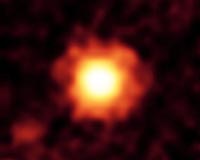 |
Salt Lake City UT (SPX) Nov 05, 2009 The University of Utah will celebrate the initial observations or "first light" of its new $860,000 research telescope in southwest Utah during a Wednesday, Nov. 11, symposium and reception on the Salt Lake City campus. The new Willard L. Eccles Observatory's 32-inch reflecting telescope took its first pictures the night of Oct. 15. The "first light" photo is an edge-on view of the spiral galaxy NGC 891, says Wayne Springer, who heads the project and is an associate professor of physics and astronomy. The new observatory, with a telescope built by DFM Engineering, is located at an elevation of about 9,600 feet on Frisco Peak, near Milford, Utah. To celebrate initial operation of the observatory, the university's Department of Physics and Astronomy will hold a "first light" celebration on Nov. 11, with a symposium at 4 p.m. in room 103 of the James Fletcher Building, followed by a 5 p.m. reception in the building's rotunda. The public and news media are invited. Springer says sources of the observatory's funding included $600,000 from the Willard L. Eccles Foundation, $160,000 from the Ezekiel R. and Edna W. Dumke Foundation, $40,000 from the university, and another $60,000 yet to be raised. He also is applying for a $300,000 grant from the National Science Foundation so the Frisco Peak telescope can be operated by remote control from campus, 250 miles away. Springer hopes it can be operated remotely by the end of summer 2010. The university announced plans for the telescope in 2006, and Springer says he is "relieved, excited and exuberant" that it has started observing the sky. For several months, astronomers mainly will be "tweaking it" - making adjustments and calibrations and evaluating observing conditions, he says. Scientific observations should begin in earnest next spring, and Springer says he hopes students will be able to use it even sooner - if another grant is approved for a tracked, all-terrain vehicle needed to reach the observatory during the snowy months. "I'm very excited about the possibilities with an observatory located on a mountaintop in a region with dark skies," he says. "We will certainly utilize the facility for education of students and for public outreach opportunities," including star parties in Salt Lake City that will use the telescope by remote control. Share This Article With Planet Earth
Related Links University of Utah Space Telescope News and Technology at Skynightly.com
 Spitzer Observes A Chaotic Planetary System
Spitzer Observes A Chaotic Planetary SystemPasadena CA (SPX) Nov 05, 2009 Before our planets found their way to the stable orbits they circle in today, they wiggled and jostled about like unsettled children. Now, NASA's Spitzer Space Telescope has found a young star with evidence for the same kind of orbital hyperactivity. Young planets circling the star are thought to be disturbing smaller comet-like bodies, causing them to collide and kick up a huge halo of dust. ... read more |
|
| The content herein, unless otherwise known to be public domain, are Copyright 1995-2009 - SpaceDaily. AFP and UPI Wire Stories are copyright Agence France-Presse and United Press International. ESA Portal Reports are copyright European Space Agency. All NASA sourced material is public domain. Additional copyrights may apply in whole or part to other bona fide parties. Advertising does not imply endorsement,agreement or approval of any opinions, statements or information provided by SpaceDaily on any Web page published or hosted by SpaceDaily. Privacy Statement |